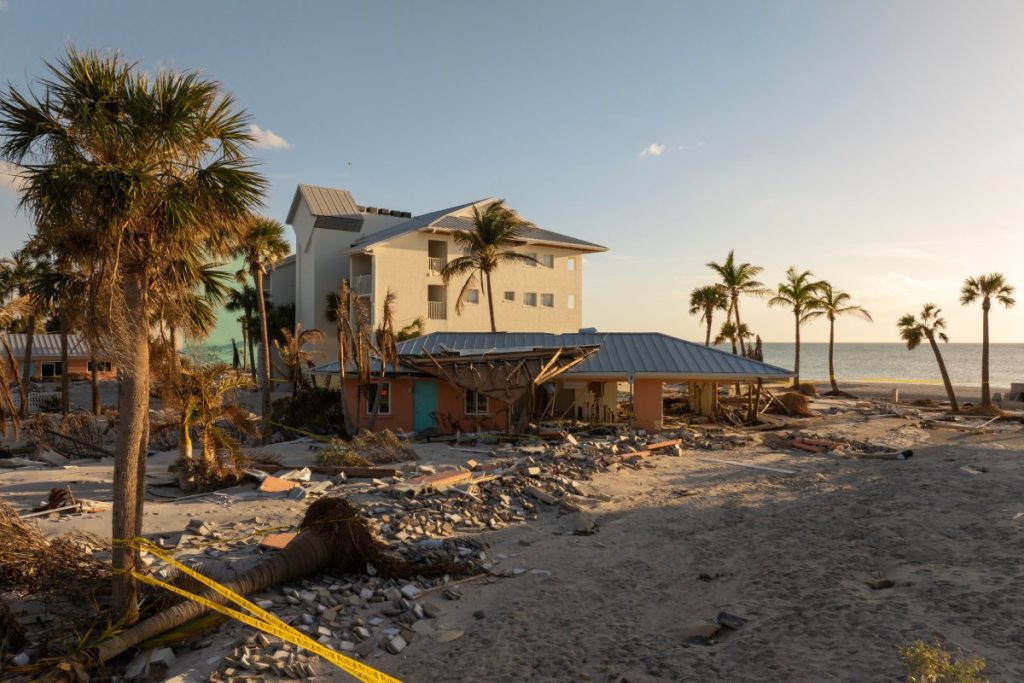Recent hurricanes Helene and Milton caused over $113 billion in combined damages across the states of Florida, North Carolina, Virginia, Tennessee, and Georgia, leaving thousands of property owners facing an unexpected financial reality: paying two separate deductibles for the same storm. While hurricane winds tear off roofs and shatter windows, storm surge floods homes from below—and each type of damage often triggers different insurance policies with separate deductibles.
Many Florida homeowners discover too late that their hurricane deductible doesn’t apply to flood damage, even when both result from the same storm system. This confusion has led to property owners paying thousands more out of pocket than anticipated, particularly when insurance companies incorrectly apply deductibles or misattribute the sources of damage.
Understanding when your hurricane deductible applies versus your flood insurance deductible can save you a significant amount of money and protect your financial interests. The distinction between wind damage covered by homeowners insurance and water damage requiring separate flood insurance coverage creates complex scenarios where proper damage attribution becomes critical.
This guide clarifies the key differences between hurricane and flood deductibles, provides real-world examples from recent Florida hurricane claims, and outlines actionable steps to challenge incorrect deductible applications when insurance companies mishandle your claim.
Understanding Your Hurricane vs. Flood Deductibles
In Florida, insurers apply specialized “hurricane deductibles” for damage caused by any storm system that has been declared to be a “hurricane” by the National Hurricane Center of the National Weather Service. Carriers must offer hurricane deductibles of either $500, 2%, 5%, or 10% of the dwelling coverage (also called Coverage A), though there are limited exceptions for higher‑value homes.
Let’s break down what that means. Most policyholders typically think about deductibles in terms of fixed dollar amounts, but percentage deductibles are calculated by the insured policy limit for the dwelling. That means for a home insured at $300,000, a 5% hurricane deductible would require you to pay $15,000 before insurance coverage begins for wind-related damages. For a home valued at $480,000, a 2% deductible would require you to pay $9,600 out of pocket.
Flood insurance deductibles operate differently, however, with separate amounts for building coverage and personal property under National Flood Insurance Program (NFIP) policies. These deductibles are fixed dollar amounts, rather than percentages.
Does Homeowners Insurance Cover Flood Damage?
Standard homeowners insurance covers wind damage from hurricanes but excludes flood damage entirely. Properties in Federal Emergency Management Agency (FEMA)-designated high-risk flood zones typically require mandatory flood insurance through the NFIP or through private insurers when securing mortgages from lenders.
FEMA oversees the NFIP, which provides coverage for one- to four-family homes for up to $250,000 for building damage and $100,000 for personal property. However, most new flood insurance policies include a 30-day waiting period before coverage begins, making advance planning essential for Florida property owners during hurricane season.
The Deductible Dilemma: When One Storm Causes Both Types of Damage
Insurance companies sometimes incorrectly apply hurricane deductibles to flood insurance claims or attempt to deny coverage entirely when both wind and water damage occur simultaneously. This misattribution can result in policyholders incurring thousands of dollars in improper deductible applications.
Because wind and flood are covered under separate policies, policyholders can face two deductibles for the same storm—one under the homeowners policy (wind) and one under the flood policy.
Anti-concurrent causation clauses in many homeowners insurance policies deny coverage when covered events (such as wind damage) and non-covered events (such as flooding) combine to cause a loss. These clauses allow insurers to reject entire claims if any excluded peril contributed to the damage, regardless of the primary cause.
Proper damage attribution requires careful documentation and expert assessment to determine whether specific damages resulted from covered wind events or excluded flood events. Insurance agents and adjusters must accurately identify the sources of damage to ensure that policyholders receive the appropriate coverage under their respective policies.
Challenging incorrect policy interpretations through thorough documentation and professional assessment can result in substantial savings. Property owners who successfully demonstrate that damages qualify for coverage under different policies often recover thousands of dollars that they otherwise would have had to pay out themselves.
What Is the Average Cost for Flood Insurance in Florida?
The cost of flood insurance in Florida varies depending on several factors, including the property’s location, its flood zone designation, and the selected coverage amounts. On average, Floridians pay approximately $865 per year for flood insurance through the NFIP. However, prices can be significantly higher for homes located in high flood risk zones or coastal areas. Properties in moderate or low-risk zones often receive lower premiums.
All property owners need to assess their individual risks and consider flood insurance coverage to protect against unexpected natural disasters. Choosing the right deductibles and comparing private insurance options can also help homeowners find coverage that suits their needs and budgets.
Real-Life Examples: Recent Florida Hurricane Claims Success Stories
During Hurricane Helene, a Tallahassee homeowner initially faced a $12,000 hurricane deductible for combined wind and flood damage totaling $85,000. Through proper damage attribution and professional assessment, the claim was split appropriately: $45,000 in wind damage, subject to the hurricane deductible, and $40,000 in flood damage, covered under the NFIP with a $2,500 deductible—resulting in a savings of $9,500 for the homeowner.
A condo owner in a Special Flood Hazard Area (SFHA) experienced both roof damage from Hurricane Milton’s winds and ground-floor flooding from storm surge. Initially, the insurance provider attempted to apply the hurricane deductible to all damages. Professional documentation separated $30,000 in wind damage from $25,000 in flood damage, resulting in proper coverage under both policies and significant cost savings.
Property owners who maintained detailed photographic evidence before, during, and after recent storms were able to successfully challenge insurer determinations regarding the cause of damage. Thorough documentation showing the sequence of damage—wind damage occurring first, followed by flood damage—helped establish clear attribution for each type of loss.
These examples demonstrate how understanding coverage differences and maintaining proper documentation can prevent insurance companies from incorrectly applying deductibles or denying legitimate claims under anti-concurrent causation provisions.
NFIP and FEMA: Essential Knowledge for Florida Homeowners
The NFIP, administered by the Federal Emergency Management Agency, provides the majority of flood insurance coverage in Florida. NFIP policies offer standardized coverage limits of $250,000 for building damage and $100,000 for contents, with separate deductibles for each type of coverage.
Most NFIP policies become effective after 30 days, except at loan closing, within 13 months of a map change, or in certain post‑wildfire situations on federal land, which may qualify for shorter waiting periods. Property owners should purchase flood insurance well before hurricane season begins to ensure adequate protection when storms threaten Florida coastal and inland areas.
Private flood insurance alternatives often provide higher coverage limits and more flexible terms than NFIP policies. These private options may cover additional living expenses and other replacement costs not covered by federal flood insurance, although premiums and coverage terms vary significantly among insurance companies.
Floodplain management regulations in many Florida communities require property owners in designated flood zones to obtain elevation certificates. These certificates help determine appropriate flood insurance rates and may qualify property owners for reduced premiums based on their structure’s elevation relative to base flood levels.
Renters in flood-prone areas should consider contents-only flood insurance policies to protect their personal property, as landlord policies typically only cover building structures. The NFIP and private insurers offer contents coverage for tenants in both high-risk and low-risk areas.
Challenging Incorrect Insurer Determinations
If your claim has been denied, you should carefully review your claim denial letter against the specific language of your insurance policy, paying particular attention to coverage definitions and exclusions. Many denials result from misinterpretation of policy terms or incorrect damage attribution rather than legitimate coverage exclusions.
Be sure to take comprehensive photographs and videos of all damaged areas to document conditions that adjusters may overlook during initial inspections. New documentation can reveal additional damage or provide evidence for a different claim about the cause.
Independent assessments from public adjusters or qualified contractors can provide objective evaluations of damage sources and replacement costs. These professional opinions carry significant weight when challenging insurance company determinations about coverage applicability or damage attribution.
Understanding the fine distinction between damage from “flood water” vs. “wind-driven rain” becomes crucial when disputing coverage decisions. Wind-driven rain entering through storm-damaged openings typically qualifies for homeowners insurance coverage, while rising flood water requires you to buy flood insurance coverage that is separate.
Property owners should maintain detailed records of all communications with insurance providers, including claim numbers, adjuster names, and specific damage attributions made during inspections. This documentation becomes essential evidence when appealing unfavorable coverage decisions or filing complaints with state insurance regulators.
When to Seek Professional Help
If you’re facing a claim denial or a significant underpayment, or if you suspect your insurer is acting in bad faith, it’s vital to consult an insurance attorney. Legal counsel can review policy language, challenge improper claim handling, and pursue litigation when necessary to protect your rights as a policyholder.
Merlin Law Group specializes in hurricane insurance claims. We have extensive experience with complex cases involving both wind and water damage attribution. Our firm operates on a contingency fee basis, meaning clients pay no attorney fees unless they recover additional compensation from their insurance claims.
Our attorneys understand the nuances of Florida insurance law and have successfully challenged improper deductible applications, coverage denials, and inadequate settlements. Our experience with hurricane claims helps property owners navigate the complex intersection of homeowners insurance and flood insurance coverage.
With offices throughout Florida and a track record of recovering over $2 billion for clients nationwide, Merlin Law Group provides the expertise needed to challenge insurance company decisions and secure fair claim settlements for hurricane damage.



